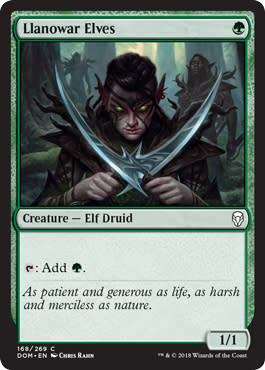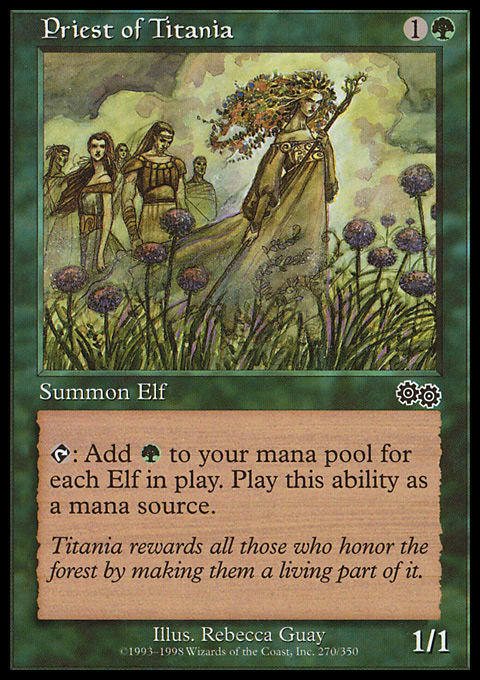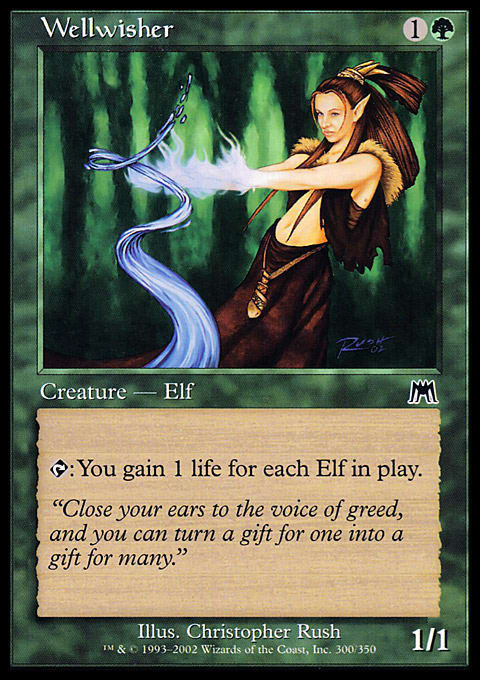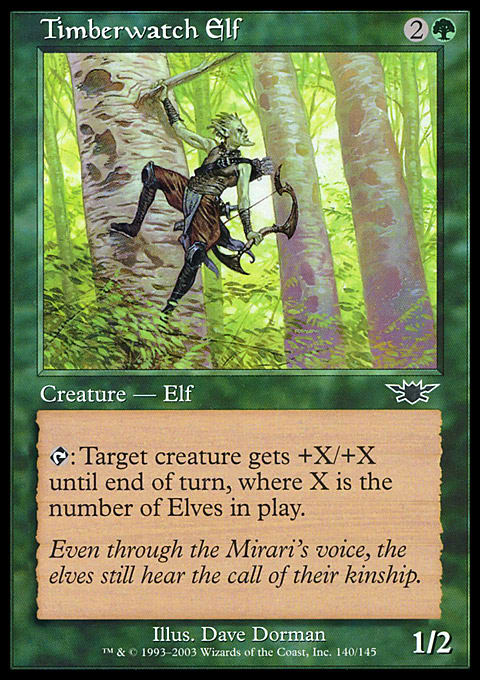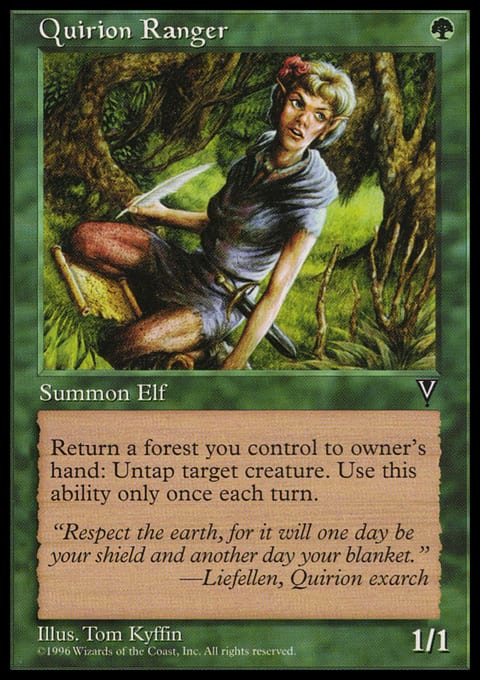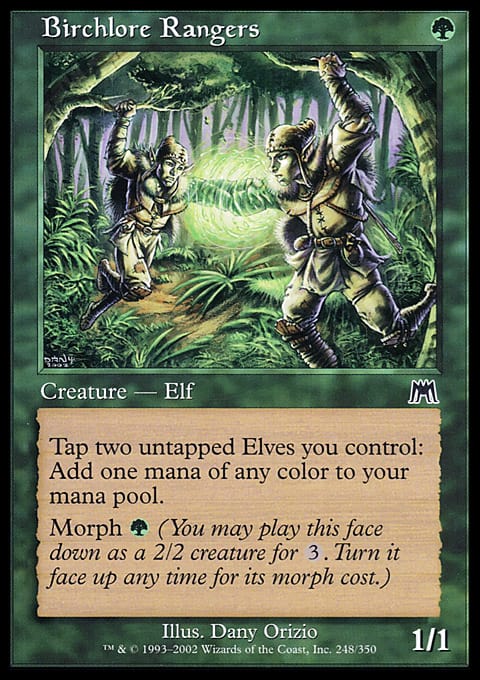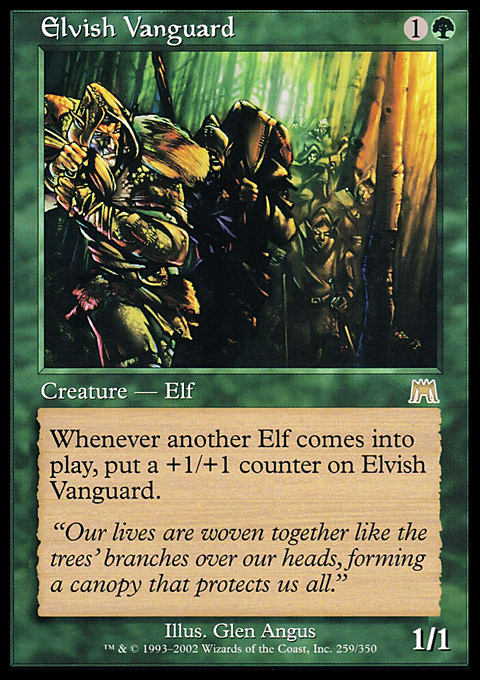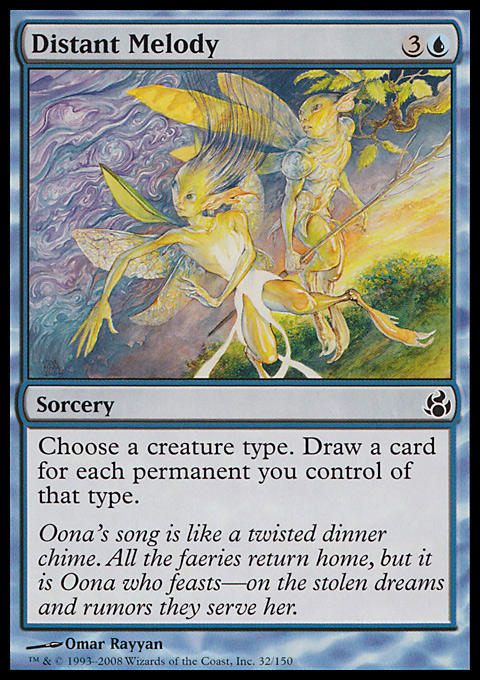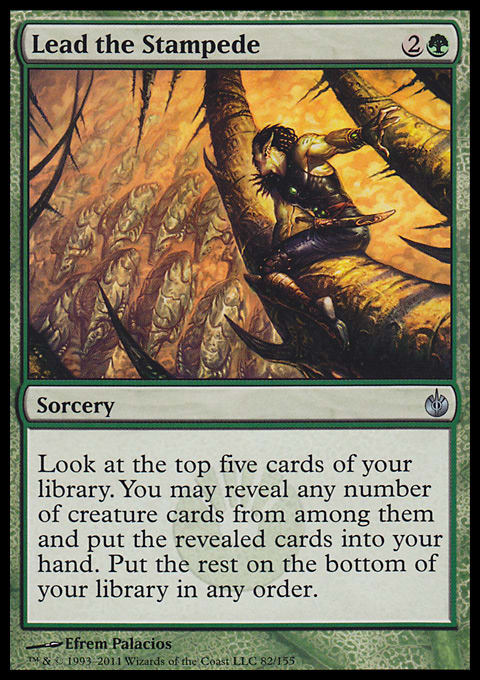The Pauper format has many kinds of decks that someone can pick up and choose to play. You can go with something as simplistic as Burn or Stompy, or you can choose something more complex, such as Tron or Familiars. With time, players can often find they have a specific taste - one particular style of play that they enjoy over others and end up sticking by as a result.
For me, I've long found a profound love in the Elves archetype. There are many reasons I love the deck. Elves was one of the first tournament viable decks I played back in the Onslaught block and many of my favorite cards from back then get to shine here. While it's a little more aggressively focused, it also can play much like a combo deck. This appeals greatly to me, especially as someone who has frequently enjoyed playing Storm-style decks in other formats.
By now I've lost count, but I've easily played multiple thousands of matchups, produced content both written and visual, and have a certain notoriety for playing the deck. Many people ask for my advice on the list, be it specific card choices or general strategy. This has inspired me to put together what I hope will be a definitive primer for the Elves archetype in Pauper, spanning over five weeks. These weeks will include the following:
- A general introduction to Pauper Elves and examining card options that often come up in the main deck. The first week will cover your typical cards you can expect to find in lists and their roles in the deck. During the second week, I'll talk more at length about less used cards and why they're good or why they're not.
- A look at different builds of Elves and discussing metagaming a bit, touching only slightly on matchups to give an understanding of why we're building decks the way we are.
- Examining specific matchups closely. This will not be all-encompassing but will cover a multitude of decks that you can expect to face at events.
- Sideboarding, including card choices, their relevance to specific matchups, and last but not least a sideboard guide for a couple different builds of the deck.
My hope is that this will help give you a better sense of how to build your deck to handle your local meta and to become a better Elves player. Because of the popularity of the deck both in paper and online, you can expect me to give a few mentions to how you should play certain cards in Magic Online as well. This, again, is to allow us to cover as much ground as possible.
With that, let's have a look at my current list, tuned for the current League metagame on Magic Online.
Elves | Pauper | Kendra Smith
- Creatures (38)
- 2 Elvish Mystic
- 2 Fyndhorn Elves
- 2 Sylvan Ranger
- 3 Essence Warden
- 3 Llanowar Elves
- 3 Priest of Titania
- 3 Wellwisher
- 4 Birchlore Rangers
- 4 Lys Alana Huntmaster
- 4 Nettle Sentinel
- 4 Quirion Ranger
- 4 Timberwatch Elf
- Sorceries (7)
- 3 Distant Melody
- 4 Lead the Stampede
- Enchantments (2)
- 1 Spidersilk Armor
- 1 Viridian Longbow
The deck is quite simple in concept, though a bit trickier to nail down until you actually play with it yourself a few times. Simply put, you are basically trying to play mana dorks really quickly, generate a lot of mana, and swarm the board with Elves. Cards like Lead the Stampede and Distant Melody refill your hand and you can keep going. You either take down your opponent by swarming heavily with Lys Alana Huntmaster tokens, using Timberwatch Elf's activated ability, or even gaining so much life they can't kill you thanks to Wellwisher. If you get Fog-locked, don't worry - we still have ways out thanks to Viridian Longbow! Simply use this with a Priest of Titania or a Nettle Sentinel and machine gun your opponent away!
Those of you familiar with my Elves builds may have a lot of questions about the above list so I'll just touch on a few quick notes before proceeding. Basically I've been expecting a bit more Burn in Leagues as a way for people to battle back Tron, so I upped my Essence Warden count to help my matchup a bit. I feel Vanguard isn't quite so good here right now because it gets removed too quickly too easily and you want to be a bit faster, so I upped my Nettle Sentinel count instead. I've also been trying out Prohibits in the sideboard and have very much been liking them, though I'm not 100% sure if three is the right number just yet.
I'll get into more details about this list and such in the coming weeks, but now I want to instead focus on each individual card the deck can offer. As mentioned above, this week will include cards that see a lot of play, and then next week will be cards that see more fringe play or are cards people ask me about frequently. As is, however, there's a very large list of cards to cover so let's dive right on in!
Llanowar Elves, Fyndhorn Elves, Elvish Mystic
These three cards are the simple core that holds things together. Llanowar Elves, Fyndhorn Elves, and Elvish Mystic are all functionally the same as one another - a 1/1 Elf Druid for ![]() that can tap for
that can tap for ![]() . By running these, along with certain other cards, they allow us to run as few lands as we do: only thirteen!
. By running these, along with certain other cards, they allow us to run as few lands as we do: only thirteen!
The numbers vary slightly with them, but by and large most lists run some seven or eight copies divided how you see fit. Generally speaking, players try to find an even split between all three as opposed to just using two versions. The reason for this is simple: Echoing Decay and Echoing Truth exist. It's not a case that comes up too often, but when it does, you'll be glad to have a mix. Personally, if I'm on seven copies - as seen in the list above - I run three Llanowar Elves, and two of each of the others so as to honor the Alpha classic.
One card some players also mention to me sometimes that somewhat falls into the category of mana dorks that cost ![]() is Arbor Elf. Arbor Elf honestly isn't as good as many people might think. There will be cases where you don't have any lands in play - usually as a result of using Quirion Ranger's ability or by falling prey to land destruction. In these situations, you still want to be able to generate mana, so the classic mana dorks are generally just going to be better. The only situation where you can really draw an advantage is with Utopia Sprawl, but then that ends up becoming a nonbo with Quirion Ranger anyways, so it's arguably not worth it. Stick with those classics!
is Arbor Elf. Arbor Elf honestly isn't as good as many people might think. There will be cases where you don't have any lands in play - usually as a result of using Quirion Ranger's ability or by falling prey to land destruction. In these situations, you still want to be able to generate mana, so the classic mana dorks are generally just going to be better. The only situation where you can really draw an advantage is with Utopia Sprawl, but then that ends up becoming a nonbo with Quirion Ranger anyways, so it's arguably not worth it. Stick with those classics!
Priest of Titania
Priest of Titania is a Llanowar Elves on steroids. This 2-drop gives you mana for every single elf on the battlefield. I want to re-emphasize something there: that means every elf on the battlefield, including your opponent's. There are plenty of players who don't realize that a number of the elves in this deck actually count both players' elves for their abilities. I'll make sure to point out every single one where this matters.
Why was Priest of Titania printed in a way that generates such an egregious amount of mana? The likely answer is that mana burn existed. This rule meant that whenever your mana pool would empty out, any mana you lost would also cause you to lose one life for each mana emptied. This rule was removed with the release of Magic 2010 and affected a number of cards in the process. Some - like Priest - got much better, while others like, say, Citadel of Pain got significantly worse.
Priest of Titania can be used to fuel a number of things, from chaining copies of Distant Melody to moving around a Viridian Longbow for lethal. Whatever the use, the amount of mana you'll generate with the Priest is tremendous and will arguably take you farther faster than any other card in the deck.
I also want to mention the card Elvish Guidance, which is an aura that you enchant a land with to get the Priest of Titania effect. Players have tried or asked me about this but - like Utopia Sprawl - it's a bit of a nonbo with Quirion Ranger. This is compounded once you start playing tons of games with the deck and discover that quite often you get stuck on just one land with a bunch of mana dorks, so you'll really feel it if you end up needing to activate that Quirion Ranger for whatever kind of ability you need it for.
Wellwisher
Wellwisher is one of my favorite cards of all time. It's quite rare for cards that do nothing but gain you life to be good, but Wellwisher is certainly the exception to the rule. This card can single-handedly gain you such an exorbitant amount of life in a single turn just by tapping it and activating its ability. If there are ten elves on the field when you activate it, then you gain ten life. Elves can get seriously out of hand, however, and in the right setting this card can generate upwards of 100 life in a single turn! Remember, this is one of the elves that accounts for all elves on the battlefield, so make sure you don't miss any life when activating a Wellwisher.
Because of the incredible amount of life that Wellwisher can net you, it can win you the game. One way is you can stall your opponent for such an incredible amount of time that you can fill your hand with cards to win the game. Elves mirror matches get so cluttered and stalled even that we need Viridian Longbow to clear boards just so that a player can win. The other way is that you gain so much life that your opponent actually is unable to defeat you by attacking you, and thus risks milling themselves out before being able to win.
Wellwisher is an extremely potent card that shouldn't be underrated. There's a reason it's one of my favorites and why it had such a big influence on me as a player growing up. It taught me different ways you can find yourself victorious in a match and just how crazy certain aspects of the game can get. Just remember, though, that for as powerful as the card is, sometimes it's right to cut some number of these. Usual numbers you can expect to see in main decks ranges from two to four copies.
Timberwatch Elf
Like Wellwisher, Timberwatch Elf is another card from my starting days of competitive Magic that made me fall in love with Elves and the game as a whole. It functions much like Priest of Titania and Wellwisher, but instead of giving you mana or life, it pumps up a creature. The exact ability is that it gives target creature +X/+X, where X is the number of Elves on the battlefield. Remember: this is another ability that counts the Elves on your opponent's side of the field.
This ability is one of our key means of victory. By attacking through with a bunch of creatures, we can try to land a killing blow utilizing Timberwatch Elf activations. Even if they prevent the damage or remove the creature you're targeting with the ability, it still forces your opponent's hand. You can also use the ability defensively so that you can protect creatures that are key to your strategy and ensure they don't get hit by, say, a Lightning Bolt.
There is a one-time effect of this ability in the format in the form of Wirewood Pride. This instant gives you a one-time Timberwatch effect for![]() . That's it, nothing else. Some players use it as a "gotcha" effect on unsuspecting opponents or else use it to, again, protect their creatures. I'm personally of the opinion that this card doesn't do nearly enough to be worth it and is one I will usually pass on. That having been said, it's not the worst option as a one-of in your list if you so choose to try it out.
. That's it, nothing else. Some players use it as a "gotcha" effect on unsuspecting opponents or else use it to, again, protect their creatures. I'm personally of the opinion that this card doesn't do nearly enough to be worth it and is one I will usually pass on. That having been said, it's not the worst option as a one-of in your list if you so choose to try it out.
Quirion Ranger
Quirion Ranger is a card that gives us a lot of reach in our plays. It allows us to generate even more ridiculous amounts of mana with our 1-drops and Priests, insane amounts of life with Wellwisher, and it wins you the game by using it with Timberwatch Elf. Even if you don't have any of these, picking up a land after floating mana from it to replay the land and get an extra mana is something you can very much do. This can often be a play that you'll want to utilize in your early games.
Remember that you can activate the ability of Quirion Ranger at instant speed as well. That means you can attack with your creatures and pump multiple times off a single Timberwatch Elf. You can also activate it and untap a Wellwisher to gain life if your opponent is representing lethal damage. Heck, you can even do something as simple as untap a Nettle Sentinel or another creature on their turn to block an attacker.
One trick I learned from Legacy Elves players: once you've activated a Quirion Ranger for the turn, turn it upside down. This obviously only really applies if you're playing in paper, but it's a good way to serve as a reminder for whether or not you used the ability that turn.
Birchlore Rangers
Birchlore Rangers puts in a lot of work as an additional mana dork. The thing about Birchlore, though, is it turns all of our Elves into mana dorks! Things get really silly when you start adding in cards like Nettle Sentinel and Lys Alana Huntmaster to the mix. It's important to note that the way Birchlore Rangers's ability is worded, it completely ignores summoning sickness. This means if two creatures just came into play, you can immediately tap them with this ability to generate mana.
Birchlore Rangers is also one of the few cards that allows us to play non-Green spells. I've seen a number of players who have a tendency to over-rely on this ability and go too deeply in non-Green spells, but I suggest against this. You want to have the smallest amount possible that you don't dilute your deck too much. Also remember that if it's a card that requires you to have a Birchlore on the field, you run the risk of having the card sit in your hand for multiple turns.
Birchlore Rangers also has an ability most people forget exists: Morph. Players tend to underutilize this ability quite a bit. If you don't need the mana generation ability so much, or else already have one on the field, you might want to consider playing the Birchlore face-down instead. Do note that when it's face-down, it's colorless, meaning cards like Prismatic Strands do nothing against it.
Nettle Sentinel
Nettle Sentinel is a pretty simple card. The card attacks, untaps for blocks, or combos with the likes of Birchlore Rangers for ridiculous amounts of mana. Consider this: If you have two Nettle Sentinels in play and you tap them for a Green mana with Birchlore Rangers, they both untap as you cast your spell. If that's a one-mana creature, you essentially cast it for free and also have an extra creature that can be tapped by Birchlore Rangers' ability.
Nettle Sentinel also acts as a sort of win condition as you can attach a Viridian Longbow to it and repeatedly cast Green spells to untap your Sentinel. This allows you to activate the ability over and over again and ping your opponent until they lose. If all else fails, it's low to the ground and efficient at getting some quick, early damage in. Because its use varies depending on the shape of the meta, this is another card I often put in the two to four copies range.
Lys Alana Huntmaster
Lys Alana Huntmaster is one of the deck's key haymaker cards. The rate at which this card generates tokens is absurd and can single-handedly take over a game simply by swarming your opponent. Even if they don't all attack in, they still fuel every other aspect of your deck. They make the effects of your Wellwishers, Priests, and Timberwatches bigger, generate extra mana with Birchlore Rangers, and can be suited up with Longbow to slowly ping your opponent. Make sure you bring tons of tokens to your matches, or else find an alternate means to represent tokens in your game. You can generate over 100 so be ready.
Even ignoring the tokens, the Huntmaster has the largest base stats of any creature you'll typically find in a Pauper Elves main deck. Because of this, it's an excellent blocker. Just be careful, though, that if you do block you may end up letting the Huntmaster die to something like an Electrickery or Firebolt that it may have otherwise been out of range from prior to combat.
Elvish Vanguard
Elvish Vanguard is an interesting card that really helped push Elves to become an actual deck in the meta. Originally a rare in Onslaught, the card was downshifted in Eternal Masters to help boost the set's Elves draft archetype. It also, thankfully, helped us a bunch too. The downshift gave Elves a way to go tall as well as wide - something that really helps in a few notable matchups. There's not really much to say because that's all it is: it's just something that gets gigantic and attacks/blocks.
As a note, remember this is another creature that counts your opponents' Elves and not just your own. I've had numerous Elves opponents during mirror matches not trigger their own Vanguards in paper events when I would play creatures. The responsibility is on you to remember your triggers, so make sure that you stay on top of it.
The triggers can be tough to keep up with, however, so I recommend talking with your opponent to try establishing a shortcut. Essentially say something like, "I'll put every creature I play for the rest of the turn on the bottom part of my board below my lands and we'll count them after I finish going off." Not all of your opponents will want to do that and will want you to instead go through the motions. However, as it's faster and easier to do it afterwards, many players in my experience will be fine with this alternative.
Sylvan Ranger, Springbloom Druid
Sylvan Ranger is a classic card for the deck and one that allows us to find our deck's lone Island the help us cast our Distant Melodies. It can also help us dig out a second land if we need it or even just shuffle our deck if we put an important card on the bottom with something like a Lead the Stampede. After that, though, it's not much better than a token made by a Lys Alana Huntmaster so that's all it really boils down to.
Springbloom Druid is a card from the recent Modern Horizons set that costs 3 mana instead of two for a very similar effect. Instead of merely tutoring out a land from your deck and putting it into your hand, this basically casts Harrow. The only difference here is that the lands end up coming into play tapped instead. This can be huge if you're looking to cast Distant Melody the same turn you play the Druid, but in testing, these situations are a bit rarer. Instead, you do thin your deck slightly and also ramp yourself ever so slightly - even if you played your land for turn.
Both of these cards are very acceptable choices. Ultimately, though, I think it'll boil down to your own personal preference since they're only so marginally different with both having pros and cons over the other.
Essence Warden
Essence Warden is one of the more meta-specific cards, but is one you can expect to see quite a bit. It's best against aggressive decks and is especially helpful at battling back Burn. Wellwisher can certainly gain you a lot of life to help you stabilize against Burn decks, but the problem is that you need to first untap with that Wellwisher. More often than not, you'll find it actually gets bolted before you can gain any life from it. With Essence Warden, you can play the Warden and immediately start gaining life by playing more creatures before your opponent has a chance to burn it away.
It doesn't do very much against decks like Delver, Mono-Black Control, or Tron, but in very specific metas, it can be an absolute house. This is why you'll tend to see either none or the two to four range, depending on the level of necessity for the card at that specific point in time.
Distant Melody
Distant Melody has long been the big payoff card for Elves. For just 4 mana, you can draw a truckload of cards. I've seen this bad boy cast for anywhere from just a few cards to upwards of twenty. This is the reason we run Blue mana sources in our deck. It simply draws too many cards to overlook and can close the game out in an instant by drawing every game-ending spell in the deck.
The card isn't without its flaws, however. First and foremost, you can't cast it without Blue mana - something only a handful of cards in your deck do. It's sadly somewhat common that you'll have games where you'll just be staring at a dead card in your hand named Distant Melody, but when you finally get that payoff, it is something sweet! It also does nothing if you have no creatures on the battlefield, meaning if you draw it after a board wipe, it doesn't help you out much.
When casting this spell, you also want to be mindful of the number of cards in your deck. Count them up if you're in paper before casting this spell. Also remember that you don't need to name "Elf" as the creature type. Sometimes it's perfectly acceptable to take a smaller draw by naming "Warrior" or "Druid." Because some creatures in the deck had their creature types updated in The Great Creature Type Update, I recommend looking up the Oracle text versions and noting the types of each creature. Only do this for regular REL events and call a judge if you have questions at a competitive REL event.
Lead the Stampede, Winding Way
If there's one downshift that truly made Elves into a serious contender of the Pauper format, however, it's Lead the Stampede. The card made huge waves when it was revealed that it was in Iconic Masters at common and people got to testing it right away in decks like Elves and Slivers. To this day, it remains a staple of both archetypes. It benefits these decks because they're so chock full of creatures that you're likely to hit multiple cards off a single Lead. Even better, unlike Distant Melody it actually helps you recover from a board wipe!
With Modern Horizons, Elves also got the addition of the card Winding Way. This is basically another, smaller Lead the Stampede, which is great! In a pinch, you can even go digging for lands, though that's oftentimes going to be a very desperate play. It does have one big drawback, however: while Lead the Stampede puts cards it can't take on the bottom of your library, Winding Way puts them into your graveyard. This is problematic for matchups where you want your cards that make you board wipe resistant, like Spidersilk Armor or else can win you the game like Viridian Longbow. As such, you need to rely on creature-based effects for your sideboard tools and while there are some great options, it lacks in some key areas.
You should also be careful in sideboarding when using these cards as you want to avoid diluting your deck so much that you stop drawing so many Elves. The more non-creature spells you add, the less actual creatures you'll see when you need them.
Viridian Longbow
Last but not least is Viridian Longbow. I've already kind of touched on this card when talking about Nettle Sentinel, Priest of Titania, and so on. To go a bit more in-depth as to why we run this card, it serves in a couple of roles. The biggest and most important is to break up mirror matches quickly and effectively so that they don't get bogged down by repeated Wellwisher activations. It also allows us to win games when we're locked out by Fog effects, usually with regards to Tron and Turbofog lists specifically.
I've even had it win other games handily. Sometimes you just have to ping away a Myr Enforcer, or tear down an opponent's Sliver army. I like to say that the Longbow is secretly the best card in the Elves main deck because it's just that versatile. In reality, you don't always want to see it, but when you do, it's going to pay off spectacularly.
And that does it for week one of the Ultimate Pauper Elves Primer! I hope you're enjoying the deep dive so far because we're just getting started! I'll be back next week to tackle some of the lesser used cards so let me know what kind of oddball cards you like to use in the comments below! Also below are some social media links, including my YouTube channel with plenty of playthroughs of Elves, so check it out if you want to see some gameplay of the deck in action.
Kendra Smith
Twitter: @TheMaverickGal
Twitch: twitch.tv/themaverickgirl
YouTube: Kendra Smith
















